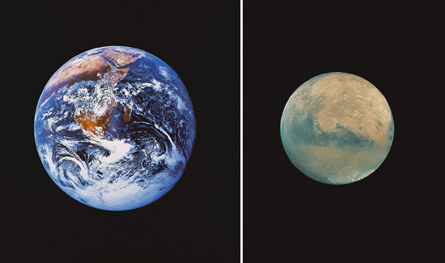Module 7
1. Module 7
1.3. Lesson 1
Module 7—Investigating the Nature of the Atom
Lesson 1—Cathode Rays and Thomson’s Experiment
 Get Focused
Get Focused

Spacescapes/Getty Images
Scientists believe that Earth’s early atmosphere was similar to the atmosphere that currently exists on Saturn’s moon Titan. Presumably, this could give rise to conditions that may support life on Titan. It is a unique moon—the only one known to have a fully developed atmosphere with more than just trace gases.
In fact, the atmosphere is so thick and the gravity so low that you could fly through it by flapping wings attached to your arms! It is 98.4% nitrogen and 1.6% methane, and it appears as thick orange smog due to reactions caused by ultraviolet radiation and methane in the upper atmosphere. How is it possible to know such complex details about a place that can’t even be seen with the naked eye?
The European Space Agency, in conjunction with NASA and the Italian Space Agency, successfully landed the Huygens probe on the surface of Titan on January 14, 2005. The proble had enough power to function during its two and one-half hour descent to the surface and for more than 90 minutes while on the surface. During that time the probe used a mass spectrometer to measure the molecular mass of the gases in the atmosphere and then sent that data back to Earth for analysis.
The molecular mass data from the probe was used to identify and confirm the type of chemicals that make up the moon’s atmosphere. Ironically, this snapshot of data, collected halfway across the solar system, was made possible by the very close examination of the infinitely small. To be precise, the mass spectrometer is a technology that was born from a similar quest for information, a quest that focused on the composition of matter and, in particular, the discovery of the electron. Approximately 105 years before the Huygens probe touched down on Titan, the electron and its characteristics were about to be discovered using similar technology.
In Lesson 1 you will learn about the discovery of the electron and its charge-to-mass ratio. You will explore early experiments with cathode ray tubes and the applications of such technologies in modern mass spectrometers.
In this lesson you will answer the following essential questions:
- How did the cathode ray contribute to the development of atomic models?
- How did J. J. Thomson determine the charge-to-mass ratio of an electron?
- How did Thomson’s experiment contribute to science and technology?
 Module 7: Lesson 1 Assignment
Module 7: Lesson 1 Assignment
Your teacher-marked Module 7: Lesson 1 Assignment requires you to submit responses to the following questions:
- Assignment—A 1, A 2, A 3, A 4, A 5, A 6, and A 7
- Reflect and Connect—RC 1
The other questions in this lesson are not marked by the teacher; however, you should still answer these questions. The Self-Check and Try This questions are placed in this lesson to help you review important information and build key concepts that may be applied in future lessons.
After a discussion with your teacher, you must decide what to do with the questions that are not part of your assignment. For example, you may decide to submit to your teacher the responses to Try This questions that are not marked. You should record the answers to all the questions in this lesson and place those answers in your course folder.